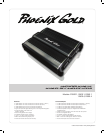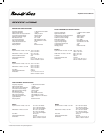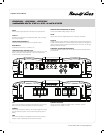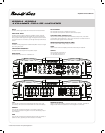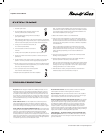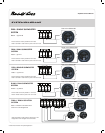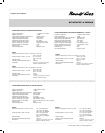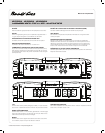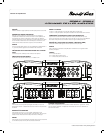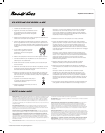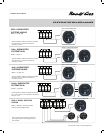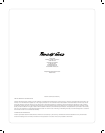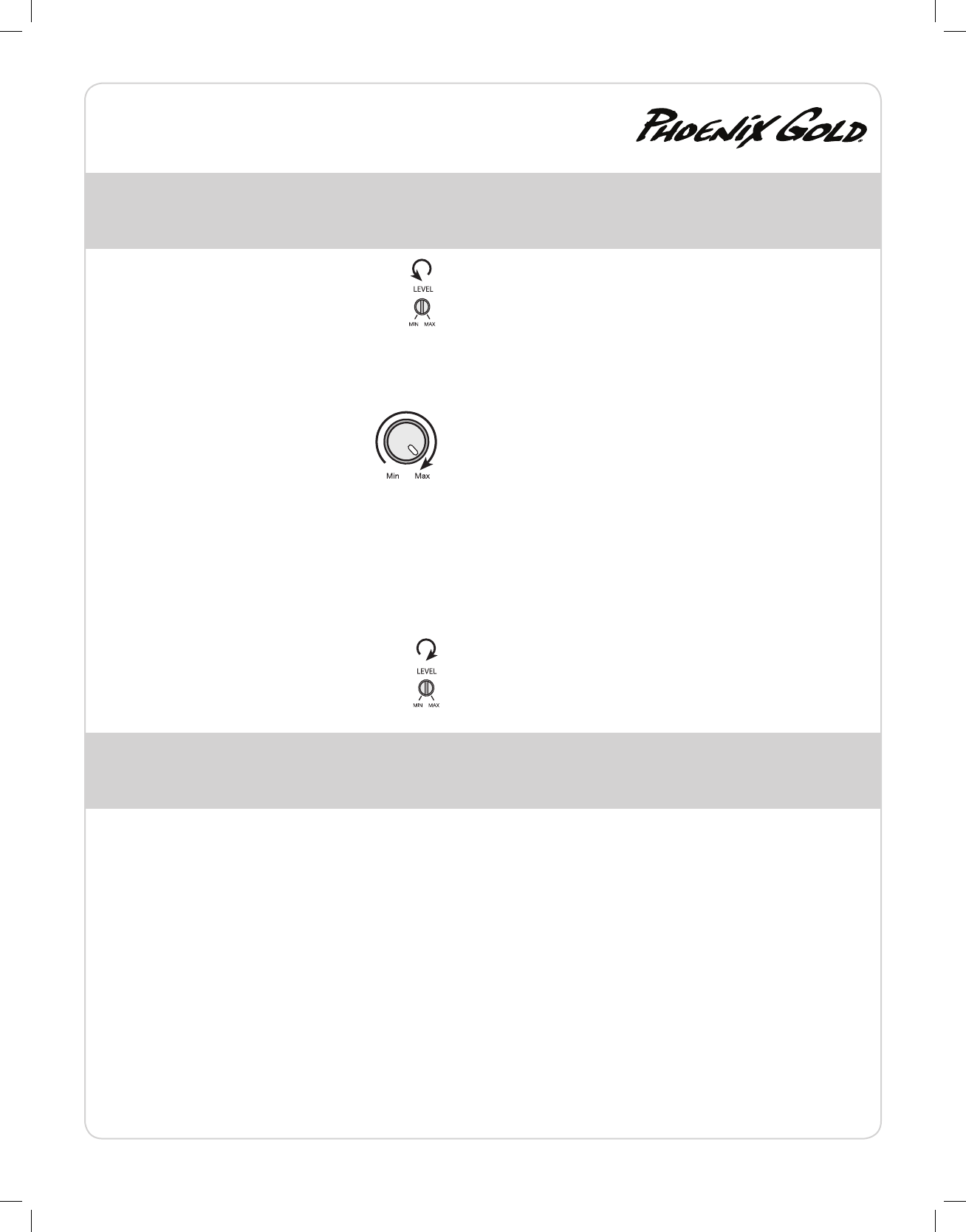
© 2010 Phoenix Gold • www.phoenixgold.com
Amplier Owner’s Manual
System tuning
TROUBLESHOOTING
1. Installallsystemfuses.
2. Settheamplier’sinputsensitivitycontrolstotheir
minimumpositions(fullcounterclockwise).
3. Setallampliersignalroutingswitchesaccordingto
yoursystem’sdesign.
4. Makepreliminaryadjustmentstothecrossoverfrequency,usually80Hz
isgoodstartingpointforhighandlowpass.Itmaybenecessarytone
tunethecrossoverfrequencylaterforthebestoverallsoundquality.
5. IfusinganLPL44RemoteLevelControl,set
ittomaximum(fullclockwise).
6. Turntheheadunitonwiththevolumesetto
minimum.
7. Visuallychecktheamplier’shaspoweredonbythepowerLED.
8. Checktheconditionofallothercomponentstomakesuretheyare
poweredup.
9. Settheheadunit’stonecontrols,balance,andfadertothecenter(at)
position.Turnoffanyloudnessorothersignalprocessingfeatures.
10.Setthevolumecontroloftheheadunitformaximumundistortedoutput
(onmostheadunitsthiswillbeapproximately7/8ofmaximumvolume).
Useaveryclearanddynamicrecording.
11.Turnuptheinputlevelcontroluntilthespeakers
reachmaximumundistortedoutput.
12.Repeatinputleveladjustmentsforallotherampliers.
Note:ThePhoenixGoldamplier’slevel,bassboostandLPL44Level
controlshavenoaffectontheauxiliaryoutputs.Anamplierconnected
totheauxiliaryoutputsreceivesthesamesignallevelavailabletothe
PhoenixGoldamplier’sinputs(unitygain).
13.Reducetheheadunit’svolumetoacomfortablelevel.
14.Listentovariousmusicalselectionstocheckoverallsystembalance.
Comparefronttorear,midbasstomidrange,etc.Ifonespeakersetis
tooloudcomparedtoanother,thenitslevelmustbeloweredtoblend
correctlywiththeotherspeakers.Theideaistoreferenceallspeakers
totheweakestset.
Note:ForsubwooferscontrolledbyanPhoenixGoldLPL44level
control,keepthelevelsettingfromstep11or12.UsetheLPL44to
blendsubwooferswiththerestofthesystem.Thecorrectsubwoofer
volumewillchangedependingonroadnoiseanddifferencesin
recordings.
15.Finetunecrossoverfrequenciestoachievethesmoothestpossible
blendingofeachspeakerset.
16.AdjusttheBassEqualizationControlsontheamplier,headunitor
processorupstreamifnecessarytoincreaseoutput.
Note:Usethesecontrolssparingly.Every3dBofboostrequiresdouble
thepowerat45Hz.Ifyoursubwoofersystemrequiresalotofboostto
soundgood,theremaybeaproblem.Lookforout-of-phasewoofers,
aleakingsubwooferbox,orincorrectboxsize.
17.Withalllevelssetcorrectly,thesystemwillreachoverallmaximum
undistortedoutputatthevolumelevelsetinstep10.
No power:CheckvoltageatamplierwithaDMM(voltmeter),B+and
REM(withheaduniton)thevoltageshouldregisterbetween12.2Vand
14.6Vwhenusingtheattachedgroundleadoftheamplier.Checkfuse
atamplierandatthebattery.Useametertoverifyconnectionfromone
endofthefusetotheother,breaksmaynotalwaysbevisible.Ifthefuseis
blown,checkthepowerwireandalsotheamplierforashort.Iftheshort
isintheamplieritself,seeyourPhoenixGolddealer.Ifnoshortispresent,
replacethefuse.
Power without sound:Turntheamplieroffandcheckallinputand
outputsignalcablesandpowerconnections.Checkthespeakersfor
shortswithaDMM(voltmeter)orbyconnectingthemtoanotheraudio
source.Aftermakingsureeverythingiscorrect,turntheamplieronagain.
Power without sound and the PROTECT LED is lit:TheredPROTECT
LEDlightswhentheampliershutsdownforeitherthermalorover-current
protection.Ahighinternalamplieroperatingtemperaturewilltrigger
thermalshutdown:afteritcoolsabout5°C,theamplierwillrestart.A
shortedspeakerleadoroperationintounusuallylowimpedanceloadswill
triggerover-currentshutdown:cyclepowerattheamplierREMterminalto
restoreoperation.Checkforshortedspeakerwiringordamagedspeakers
orcrossoversystemsifover-currentshutdownoccurs.
No sound from one side:Checkthebalancecontrolintheheadunit.
Checkspeakerconnections.Checksignalinputconnection.
Very low output:Checkyourheadunit’sfadercontrolortheamplier’s
inputsensitivitylevel.MakesureHPfrequencycontrolisnotsettoohigh
andLPfrequencycontrolisnotsettoolowatthesametime.
Frequent amplier shutdown with automatic recovery:Thisindicates
chronicamplierthermalshutdownbecauseofoperationatconsistently
highinternaltemperatures.Highoperatingtemperaturecanbecaused
byinadequateventilation.Makesureyouarenotrunningalowerthan
recommendimpedance.Alsocheckfordamagedspeakersorpassive
crossoversystems.Finally,chronicthermalshutdownmayresultfrom
otherwisenormaloperationoftheamplieratelevatedoutputpowerlevels,
whichcanberesolvedbyprovidingadditionalampliercooling,installinga
higher-poweramplier,orreducingamplieroutputlevel.
“Motor Boating” - the power indicator going off repeatedly when
the audio system is on:Checktheamplier’sconnectiontothebattery.
Checkbatteryvoltage.Iflow,rechargeorreplacethebattery.Checkall
groundconnections.



